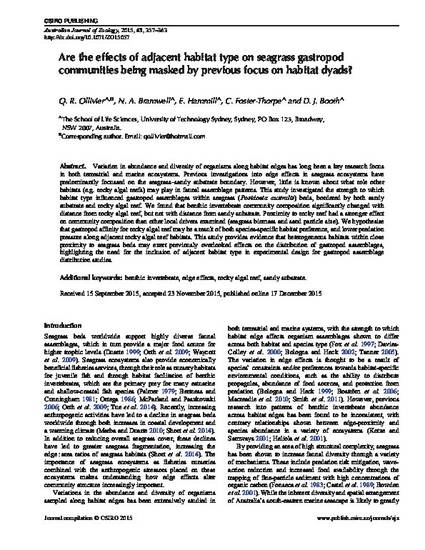
Article
Are the effects of adjacent habitat type on seagrass gastropod communities being masked by previous focus on habitat dyads?
Australian Journal of Zoology
(2015)
Abstract
Variation in abundance and diversity of organisms along habitat edges has long been a key research focus in both terrestrial and marine ecosystems. Previous investigations into edge effects in seagrass ecosystems have predominantly focussed on the seagrass–sandy substrate boundary. However, little is known about what role other habitats (e.g. rocky algal reefs) may play in faunal assemblage patterns. This study investigated the strength to which habitat type influenced gastropod assemblages within seagrass (Posidonia australis) beds, bordered by both sandy substrate and rocky algal reef. We found that benthic invertebrate community composition significantly changed with distance from rocky algal reef, but not with distance from sandy substrate. Proximity to rocky reef had a stronger effect on community composition than other local drivers examined (seagrass biomass and sand particle size). We hypothesise that gastropod affinity for rocky algal reef may be a result of both species-specific habitat preference, and lower predation pressure along adjacent rocky algal reef habitats. This study provides evidence that heterogeneous habitats within close proximity to seagrass beds may exert previously overlooked effects on the distribution of gastropod assemblages, highlighting the need for the inclusion of adjacent habitat type in experimental design for gastropod assemblage distribution studies.
Disciplines
Publication Date
2015
DOI
http://dx.doi.org/10.1071/ZO15057
Citation Information
Edd Hammill. "Are the effects of adjacent habitat type on seagrass gastropod communities being masked by previous focus on habitat dyads?" Australian Journal of Zoology Vol. 63 Iss. 5 (2015) p. 357 - 363 Available at: http://works.bepress.com/edd-hammill/37/
